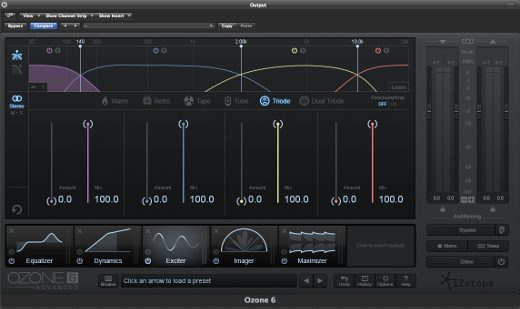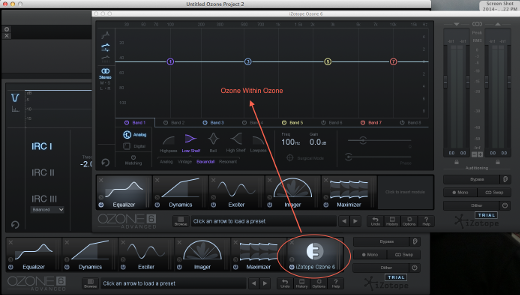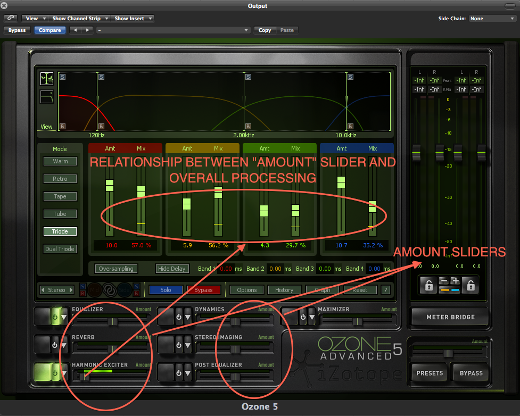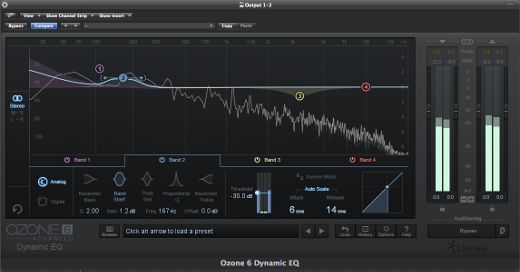Review: A Practical Look at iZotope Ozone 6 – by Nick Messitte
Many years ago, I got a chance to sit behind a name-brand producer/engineer (no names here, only credits: One Direction, Flo Rida, Leona Lewis) and watch him mix a song for the band Augustana.
There was a bit of contention: This particular producer/engineer saw no such slash in his title; he believed in his mix; he was attempting to beat out another engineer whom the label had hired.
Watching him work was alternately validating (“Yep, I do that too!”) and inspiring (“Ohhhhh that’s how you do that!”), but towards the end of the mix he did something I had never seen a renowned professional do before:
He popped a software limiter onto the end of his stereo buss (Sonnox, if memory serves) and pushed the song really, truly hard—hard enough to step on the mastering engineer’s toes.
So I opened my big mouth: “Isn’t that going to make life harder for the mastering engineer?”
This, it turns out, was exactly the point: he had no say when it came to the mastering engineer; that was the label’s choice. Who could predict what the mastering engineer would do? Who could predict which mastering engineer the label would hire?
No. For this situation, it was far better to protect the integrity of his mix against the possibility of a sloppy mastering job; to master it as much as possible on the mixing end; to maximize loudness, width, and tonal excellence while keeping the transients intact.
This was my professional introduction to the world of DIY mastering—or to put it bluntly, my first lesson in how to protect your track from a mastering engineer you don’t know, and therefore, don’t trust.
About five years have past since that session—five years of unbelievable improvements in the world of digital; five years that brought us the Slate FG-X, the Ozone 5 mastering bundle, and the FabFilter Pro bundle.
Now iZotope offers a new iteration of its Ozone bundle, Ozone 6, and once again, the boundaries for what you can do with software in the mastering process have been successfully pushed.
Let’s take a look, shall we?
UNDER THE HOOD
The first thing you’ll notice upon instantiating Ozone 6 (or operating it in standalone mode) for the first time is the drastic change to their graphic user interface.
Gone are the emerald greens isles of previous Ozones. Now the coloring scheme is quite different: light lines of blue against a flat black background, with bands depicted in a sliding scale from purple to red via gradations of the color spectrum (ROYGBV). The metering has changed as well—turquoise, rather than bright green.
Almost immediately, the new interface reminded me of a conversation I had with Jefferson Hobbs, Lead Developer on iZotope’s RX team; in an interview for Forbes.com, he told me that “Blue is actually made in the brain. It actually takes a little bit longer for the brain to comprehend that, so it’s great as background color.”
This struck a chord: the fact that blue—a color that takes longer to register in our brains—dominates this UI is indicative of something, at least to me:
If blue really makes us stop and think (even for a split second), then the new blue-on-black color scheme must be intended to make us stop and think as well. Personally, I like this. Stopping and thinking is a vital mindset for mastering, especially in a DIY/home setting.
In addition to color changes, the interface has been streamlined and simplified—wide sliders have been reduced to slick indications, for example.
The press release claims these simplifications were enacted to create “an elegant visual aesthetic and fluid workflow…in order to bring the creative elements of mastering front and center and allow users to define their own sound.”
Now, I’m a skeptical curmudgeon by nature, so this kind of speech tends to make me wary—especially when it comes to mastering plugins. My tendency is to think, “I want more technicalities, damn it! More variable controls! More parameters! More…things!”
I must confess that the idea of simplifying Ozone’s already excellent interface to further some “visual aesthetic” seemed anathema to me; it was such visual “streamlining” that forced me out of my preferred DAW (Logic) and into Pro Tools.
Indeed, after dealing with the Garageband-tinged UI of Logic Pro X, I had made up my mind: hefty re-inventions in favor of aesthetics always seem to backfire.
So imagine my delight in finding Ozone 6’s new UI to be largely helpful. Features which used to lurk behind that pesky option screen now exist right out there in the open (the ability to level match when A/B’ing against bypass mode, for instance, or the “surgical” option for the EQ).
This vastly improves the UX (user experience): With so many vital and heretofore closeted features now openly placed, you’re free to dive into the sonics of mastering—the actual meat of it—much faster.
Want to switch the order of the modules? No need to squint for the fine print and click on a box to open some matrix window; just drag and drop at the bottom of your screen and hear the difference immediately. Ozone 6 is filled with many such improvements to the overall experience.
Perhaps my favorite improvement is the new default settings for crossover bands between components.
This is a big step forward, at least for me; in previous iterations, if you wanted to set the bands of two different modules independently (for example, if you wanted to widen a band between 1 and 5k while simultaneously compressing a band between 3 and 6k), you had to manually locate that option and set it yourself upon instantiating the plug. In Ozone 6, such independence between modules is the new normal.
Some of these streamlining maneuvers carry over into the individual components themselves, often with favorable outcomes: the advanced section of Ozone 5 offered you five different algorithms for the Maximizer (fast, slow, IRC I, IRC II, and IRC III); Ozone 6 does away with two of these algorithms altogether (fast and slow), and to be honest, I did not miss them.
But unfortunately, some of the old features have been simplified out of existence: Both the dynamic gate and the mastering reverb have left us entirely, most likely because their practical uses are few and far between.
Yet sometimes I found myself wishing I could reach for these discontinued features: In one of my tests, I needed the reverb in order to soften up a particularly dry Jazz mix.
Luckily, Team Ozone has accounted for this, albeit in a slightly roundabout way; in standalone mode, you can port third party plugins into your chain—you can instantiate the Ozone 5 reverb if you so choose, or indeed, any reverb. Heck, you can even port in a whole new instantiation of Ozone 6, something MC Escher would probably do if he were an audio engineer:
There are, however some real downsides to this overall ethos of re-invention/simplification, and here’s an example: Ozone 5 gave you an “amount slider” which basically functioned as a mix knob for all applicable effects: Exciter, Imager, and Dynamics.
As you can see above, you could affect the amount of overall processing with these highlighted sliders.
But no such across-the-board functionality seems to exist in Ozone 6; if you want to enact broad scale reductions across an entire module, you’ll have to keep the relationships correct in your head as you work with each individual slider.
So yes, there are some downsides, but in practical applications, these downsides don’t present all that much of a problem, as you can always reach for an instance of Ozone 5 (or even 4) to complement 6.
I believe this is the coolest thing about the entire Ozone line: iZotope doesn’t merely improve upon an algorithm, they incorporate it into an already astounding ecosystem of DSP.
The sound of Ozone 6 is indeed excellent—but so was the sound of Ozone 5 and Ozone 4; iZotope has always ridden a fine line between improving their sonic capabilities and offering updated “takes” on classic Ozone aesthetics, and the net result is compounded versatility:
Just because I like the sound of Ozone 6’s Exciter doesn’t mean I won’t reach for Ozone 4’s Imager (which I really enjoy), and thankfully, iZotope’s upgrades allow me to do just that.
Of course, I would be remiss if I didn’t mention that Ozone 6 has given us an entirely new module: the Dynamic EQ (available in the advanced edition only).
Up until last week, I believed one multiband plugin towered above all the others: the Fabfilter Pro MB.
I couldn’t stand how other digital multiband compressors affected the rest of my mix—how they influenced the bands I wasn’t compressing; I always fought against the life-draining qualities of multiband processing until I stumbled upon the FabFilter Pro MB.
But with Ozone 6’s Dynamic EQ, I’ve found a process which can stand up to FabFilter—something which even gives FabFilter a run for their money; it’s quite a lovely feeling to know I have two trustworthy options in my band-specific dynamic arsenal, as opposed to one.
Of course, I’d love to be able to “click in” as many bands as I deem necessary, as you can with FabFilter’s frequency based products; indeed, there’s a lot more I would like to see within Ozone 6:
That drag-and-drop module window at the bottom—wouldn’t it be cool if it were endlessly expandable, if I could instantiate as many components as I wanted to? Right now, you’re stuck with one instance of a module in a set, predetermined number of slots.
Likewise, I’d love to see Ozone take their new defaults further: those aforementioned, independently variable crossover points—wouldn’t it be fantastic if I could set separate bands not only between modules, but between Mid/Side as well? Imagine the versatility!
Yet somehow I’m not disappointed about what could be improved. For one thing, you can always pop on another instance of the plugin (although, to be fair, Ozone 6 is fairly CPU intensive; my system craps out after three instantiations).
For another, iZotope has proven again and again that they listen to their customer base (for examples of this, read my Forbes.com on article RX).
What iZotope has given us is basically excellent—from the EQ to the Insight metering platform (available in the advanced iteration only)—and there’s every indication to believe that improvements will be made to whatever is lacking.
But enough of me bloviating. Let’s take this sucker for a spin.
TESTS!
To test Ozone 6, I concocted two different experiments, spotlighting two different concepts: 1) let’s see how far we’ve come in the world of digital mastering, and 2) let’s see how well Ozone 6 stands up to the professional mastering world.
Keep in mind the following caveat as you listen to these tests: I have had Ozone 6 in my arsenal for all of four days.
I don’t know about you, but my learning curve on new plugins is a bit steep—usually my results sound a whole lot worse before they sound better because I tend to go hog-wild with new toys. Only after a couple of weeks do I begin to understand how to use a new piece of software subtly. That’s just how my particular brain works.
That having been said, I’m pretty happy with these results. Soon, you’ll be the judge.
THE FIRST TEST: HOW FAR HAVE WE COME?
For this test, I’m going back to the beginning of my mixing career: one of the first records I mixed was an album of modern Jazz entitled “Gift.” Jayme Silverstein wrote the music (he’s now a touring bass player for Miguel and Nico & Vinz).
I believe the mix was decent, but you’d never know it—the mastering engineer totally messed it up. To be fair, the mastering engineer was also me; budget constraints deemed that necessary. So I did what I could with what I had at the time: good converters (Cranesong Hedd 192, Lynx Aurora 16), an API 2500, and a bunch of Waves plugins.
Never mind the gear though; my talent for mastering, as you’ll soon hear, was lacking.
Here’s the initial mix.(“Gift” — no mastering):
Now, Here’s my DIY, hack-job master of many years ago (“Gift” — Original Master).
So here’s the test: if I only used Ozone 6, could I fashion a master that would trounce the original and compete with similar offerings in the current modern Jazz landscape?
Turns out the answer isn’t just “yes”—it’s yes, and how (“Gift” — Ozone 6 master):
Compare with “Gift” — Ozone 6 master, 2nd pass:.
Compare with “Gift” — Ozone 6 master, 3rd pass:
These are three completely different masters, each of them treated in an increasingly aggressive manner. To my ears, each example trumps the harsh, boxy, and narrow qualities of the original master from so many years ago; played against modern Jazz tunes of a similar ilk, all of these examples stand up.
All of this was accomplished efficiently and expeditiously using one plugin.
Let’s move on to the next test.
SECOND TEST: OZONE 6 VERSUS AN ESTABLISHED MASTERING HOUSE
In 2011, I mixed a single, “Battery,” for the Chicago-based Indie band Empire State Express. Here’s a snippet of the original mix, with nothing on the stereo buss:
“Battery” — Original Mix:
Here’s the reference master I handed in to the mastering engineer (“Battery” — Original L2’d Reference):
Loud, yes, but also quite lifeless and digital sounding.
At this point in my mixing practice, I was still slamming things for clients with Waves’ L2s.
I had nothing in the way of hardware limiters. I boasted no Slate products, no FabFilter bundles. I had only started to use Ozone 5—and I was using it rather unsubtly.
The final master ultimately blew mine away; of course it did: the mastering engineer was Grammy nominated, worked at one of New York’s premier mastering houses, and sported credits such as Kaiser Chiefs, Jimmy Cliff, and Bjork. More than that, I’ve always dug this engineer’s style, hence my continued recommendation to use this person whenever possible.
“Battery” — Original Master:
A rock solid master.
So here’s the question: after three years of digital innovations—three years of better algorithms and better sonics—could I compete with this analogue master in the digital world, DIY style, at home, with only Ozone 6?
Let’s find out (“Battery” — Ozone 6 master):
I believe that for this snippet of this song, Ozone got right up in the previous master’s headspace. Now, to be fair, I do believe that the analogue, expensive mastering job wins out, especially in the upper mids. Plus, the original breathes in a way that the Ozone master hasn’t quite matched; listen to the cymbal hits to really hear what I’m talking about.
Still, I’m not considering this a defeat: With Ozone 6, I’ve gotten very close—much closer than I’ve ever come before, and close enough to impress my friends in mastering circles (they too tended to side with the analog master, but found the Ozone had its own comparable virtues).
Mind you, this is after four scant days of using the product. Imagine what one could do with a thorough understanding of this software?
For me, the alacrity with which I achieved a reasonable result is proof that iZotope has achieved their purported goal: “an elegant visual aesthetic and fluid workflow…in order to bring the creative elements of mastering front and center.”
Certainly this streamlined workflow worked when it came to eliciting fast results of sterner stuff than my old L2’d references.
That having been said, it would be irresponsible for me not to issue the following disclaimer: Mastering your own mix is always a risky endeavor. It’s somewhat like editing your own article—you’re bound to let a few typos slide, only in this case, the harmless typo could be an unmitigated frequency ripping your head off.
Mastering my own work is something I always advise my clients against—indeed, I readily provide the names of well respected engineers anytime a client asks me to put on the mastering hat.
However, not all situations are created equal. Sometimes budget constraints force you to master your own mix. Sometimes you don’t have final say over who’s going to master the project, no matter how loudly your name rings out.
In situations such as these, Ozone 6 gets the job done. More than that, it gets the job done remarkably well. It’s as simple as that.
– As a composer of musicals, Nick Messitte has seen his work enjoy the stages of Edinburgh’s Fringe Festival and New York’s Musical Theater Festival to critical acclaim; as a guitarist, he’s played with internationally renowned musicians, including Sam Rivers, Hawksley Workman, Gary Thomas, Devin Grey and Daniel Levine. Nick is also a sound designer of theater and film (with credits such as the award winning I Hate Myself and Sumi) and a producer/engineer of records (credits include Bullet Proof Stocking’s critically acclaimed EP Down To The Top, which Nick mixed, mastered, and supplied with additional instrumentation). Lastly, he is a writer/cultural critic, whose musings can be seen regularly at Forbes.com.
Please note: When you buy products through links on this page, we may earn an affiliate commission.











balage
January 18, 2015 at 6:19 am (9 years ago)Cool review , I have the advanced
version . Guy on YouTube bashing ozone6
Has no idea about mastering. I’m
Happy they got rid of the sliders
And the mediocre reverb. 10/10
LBIL
February 27, 2015 at 10:24 am (9 years ago)Hello, I’m just starting to learn mixing and mastering and have been learning Ozone 5 and thought to check 6 out. The original master sounds better in some ways, but worse in others when compared to your attempts in Ozone 6. Wish that L2 slamming wasn’t in there at all and that it never became trendy as it just makes everything sound lifeless and constrained. Why clients want that I have no idea. This whole slamming limiters thing doesn’t make stuff sound louder, just flatter. Then radio stations make it flatter still with their equipment. The first time I ever noticed the choir in Sam Smith’s Stay With Me was when I played the cd. The radio stations around here filter it out to almost nothing. Do you think that to remain employed in this industry engineers have to pay lip service to all these bad mastering techniques as if there’s validity to squashing everything?
CD and downloads are such an inappropriate product for 2015 anyway. Multimedia discs featuring different mixes and masterings along with videos and other content people could download onto a mobile device or pop in a blu ray player or video game system seems a lot more like something people would buy. One can buy the whole Saw franchise on blu ray for I think $15-$20 at Best Buy. Why would that same consumer then want to spend $15 on a cd with squashed audio and other problems?
CDs with squashed waveforms from the 90s seem to have a lot more life. Maybe they were only using the L1 back then. I’ve heard the L2 is the big squashed between all the major limiting plugins and has been surpassed by Ozone, Pro-L, and Xenon.
Thanks for the article and I bet with the added experience since writing it you could top that original mastering.
Den
July 14, 2016 at 4:06 am (8 years ago)Hello, I’m new in mastering and wanted to ask for help from the experts.
I am mixing – megamix – songs ripped from vinyl (80s and 90s). The songs are varied concerning the quality, some have more loud bassdrum other less, also various recording volumes each vinyl had at that time.
My questions are the following…
– If I use Ozone 6, will I have to master the final megamix or each song separately?
– Is there an option in Ozone 6 to automatically adjust the complete megamix qualities according to an approximate level of the megamix data or have I have to do this manually?
– Is there any other software to do this more automatically?
Thanks in advance.